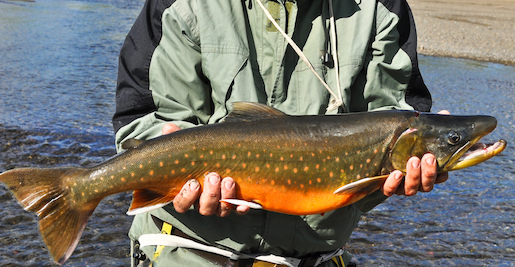Arctic Charr Summer Fishing

Summer is Spring
Summer in the arctic is much like spring in much of southern Canada and the northern United States. However some parts can see temperatures as high as 86°F/30°C. Days are very long and so are the fishing opportunities.
Where to find the Arctic Char
- Look for Arctic Charr along the coast near rivers as they empty in to the ocean
- Ocean going Arctic Charr will empty from the lakes during this time
The only lakes that will still have Arctic Charr are those that are land-locked. The coastal estuaries offer the best opportunities for Arctic Charr during the summer.
The eggs of the Arctic Charr start to hatch in April in the southern part of their distribution. By summer, the juvenile Arctic Charr stay in their birth place for about 4 years before migrating to the ocean for the first time.
Any young Arctic Charr caught in the ocean will be at least 4 years old.
Summer Fishing Techniques
The best place to catch Arctic Charr in summer is along the coast where rivers and streams empty into the ocean. Most of the prime spots don’t have any roads and you’ll need to be flown in.
- Boats are not available for most places so chest wadders are recommended
- Cast your line far into the deep water from the coast by wading in to the water
- Spoons and spinners are a good choice with medium tackle
No more than 10 pound test line is required if you want any form of challenge.
Streamer flies and jigs are also highly effective at landing Arctic Charr. But most importantly, have spare parts, spare lures and spare line as there’s no tackle shop anywhere close to where you’ll be fishing.
Summer is characterized as a time of endless sun during the summer, but the number of days of complete sun varies from one day right at the edge of the arctic circle to 3 months at the pole.
Areas close to the arctic circle don’t see any darkness for months due to the twilight.
In the northern-most part of the Arctic Charr’s distribution, summer lasts no more than 6 weeks before temperatures begin to drop and spawning once again starts. At the end of summer, the ice sheet begins to advance again.
In the southern-most reach of the Arctic Char’s distribution, summer is much longer, lasting several months. However, unlike the south, August is the beginning of winter conditions with weather worsening by the week.
Snow is possible and any angler better be prepared to endure harsh weather and temperatures as flash storms are possible. The Arctic climate is something that must be respected.
Again, a trip into this part of the world without a guide and proper planning is risky.


